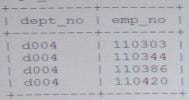Exam Details
Exam Code
:1Z0-882Exam Name
:MySQL 5.6 DeveloperCertification
:Oracle CertificationsVendor
:OracleTotal Questions
:100 Q&AsLast Updated
:Jul 03, 2025
Oracle Oracle Certifications 1Z0-882 Questions & Answers
-
Question 51:
Consider the statements: Mysql> drop function foo; ERROR 1305 (420000): FUNCTION test, foo does not exist Mysql > show warnings;

Mysql> get diagnostics condition 2 @msg=MESSAGE_TEXT; What is the result of the final statement?
A. An empty result is returned.@msg is set to message of the warning.
B. A warning message is generated that adds error 1758 (invalid condition number) to the diagnostics area.
C. A line will be an output to the error log that contains the warning message details from the failed command.
D. An error is generated as only one condition can exist in the diagnostics area.
-
Question 52:
You attempt to create a temporary table by using the following statement:
CREATE TEMPORARY TABLE employeesMAIN SELECT * FROM employees1 UNION ALL SELECT * FROM employees2;
What is the result?
A. An error is produced because you cannot create a TEMPORARY TABLE with a UNION.
B. The employees common to both tables exist in employees MAIN.
C. A unique list of employees exist in employeesMAIN.
D. All rows from both tables exist in employeesMAIN.
-
Question 53:
Consider the structures of the country and countrylanguage tables.
mysql >DESCRIBE country;

mysql> DESCRIBE countrylanguage;

Which query will give you the list of all European countries where German is spoken?
A. SELECT Code AS c, Name FROM Country WHERE Continent = `Europe' AND EXISTS ( SELECT * FROM CountryLanguage WHERE CountryCode = Code And Language= `German' )
B. SELECT Code AS c, Name FROM Country WHERE Continent = `Europe' AND Name IN ( SELECT * FROM CountryLanguage WHERE CountryCode = Code AND Language ='German' )
C. SELECT Code AS c, Name FROM Country WHERE Continent = ` Europe' AND EXIST ANY ( SELECT Language, CountryCode FROM CountryLanguage WHERE CountryCode =Code AND Language = `German' )
D. SELECT Code AS c, Name FROM Country WHERE Continent = `Europe' AND ( SELECT * FROM CountryLanguage WHERE CountryCode =Code AND Language ='German' )
-
Question 54:
Consider the my_table table with two integer columns, a and b, and the contents as shown; Mysql > SELECT a, b FROM my_table;

1 row in set result of this query?
SELECT a--b
FROM my_table;
A. 0
B. 2
C. 4
D. An error message
-
Question 55:
Examine the fruit and wine tables: Fruit

You execute this query:
SELECT fruited, fruitname FROM fruit
UNION
SELECT id, name, country FROM wine;
What is the result?
A. The query succeeds and returns five columns of data.
B. The query succeeds and returns two columns of data.
C. The query falls because UNION does not work on tables with different number of columns.
D. The query falls because the number of columns in the SELECT in the SELECT clauses are not equal.
-
Question 56:
Inspect the query:
Mysql>SELECT dept_no, emp_no FROM employees JOIN dept _manager USING(emp_no) WHERE
dept_no'd004';

4 rows in set (0.00 sec)
Mysql>EXPLAIN SELECT dept_no, emp_no FROM employees JOIN dept_manager USING (emp_no) WHERE dept_no='d004';

2 rows in set (0.00 sec)
Which two statements are true about the EXPLAIN output?
A. All data for the result is read from the indexex.
B. The PRIMARY KEY is used for filtering in both tables.
C. The minimal number of rows possible are read.
D. The dept_manager table has 4 times as many rows than the employees table.
-
Question 57:
Given the data from table t1:

This DELETE command is executed: DELETE FROM t1 ORDER BY b.a DESC LIMIT 2; Which set of rows will be deleted by the command?
A. (7,1) and (1,4)
B. (2,8) and (1,4)
C. (7,1) and (10,8)
D. (2,8) and (10,8)
-
Question 58:
Which two keywords cannot be used in multi-table deletes?
A. USING
B. ORDER BY
C. LIMIT
D. IGNORE
E. JOIN
-
Question 59:
Consider the query and its output:
Mysql> SELECT Language As Lang FROM countrylanguage ->WHERE countrycode ='GBR';

A user wants to have an output as shown:

What query would achieve this?
A. SELECT GROUP_IMPLODE (Language) As Lang FROM countrylanguage WHERE countrycode= `GBR';
B. SELECT GROUP_CAT(Language) As Lang FROM countrylanguage WHERE countrycode='GBR';
C. SELECT GROUP_CSV(Language) As Lang FROM countrylanguage WHERE countrycode='GBR';
D. SELECT GROUP_CONCAT (Language) As Lang FROM countrylanguage WHERE countrycode='GBR';
-
Question 60:
Consider the CREATE FUNCTION statement:
CREATE FUNCTION countrycount ()
BEGIN
DECLARE count INT;
SELECT COUNT (*) INTO count FROM country;
RETURN count ;
END
What is the outcome when you try to create the function?
A. An error results as the SELECT must assign the return values to a user variable.
B. An error results as the count variable is not initialized with a value.
C. An error result as the function must be defined with the CONTAINS SQL clause.
D. An error result as the variable type returned by the function must be defined with a RETURNS clause.
Related Exams:
1Z0-020
Oracle8i: New Features for Administrators1Z0-023
Architecture and Administration1Z0-024
Performance Tuning1Z0-025
Backup and Recovery1Z0-026
Network Administration1Z0-034
Upgrade Oracle9i/10g OCA to Oracle Database OCP1Z0-036
Managing Oracle9i on Linux1Z0-041
Oracle Database 10g: DBA Assessment1Z0-052
Oracle Database 11g: Administration Workshop I1Z0-053
Oracle Database 11g: Administration II
Tips on How to Prepare for the Exams
Nowadays, the certification exams become more and more important and required by more and more enterprises when applying for a job. But how to prepare for the exam effectively? How to prepare for the exam in a short time with less efforts? How to get a ideal result and how to find the most reliable resources? Here on Vcedump.com, you will find all the answers. Vcedump.com provide not only Oracle exam questions, answers and explanations but also complete assistance on your exam preparation and certification application. If you are confused on your 1Z0-882 exam preparations and Oracle certification application, do not hesitate to visit our Vcedump.com to find your solutions here.